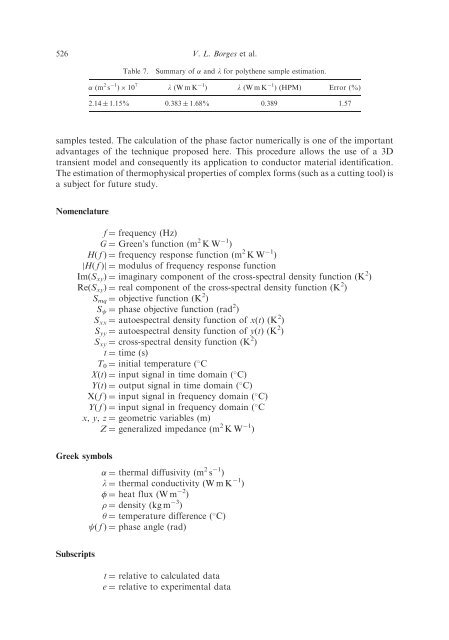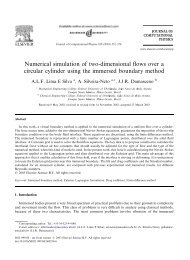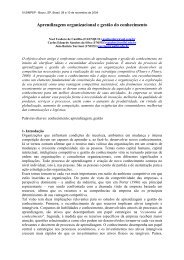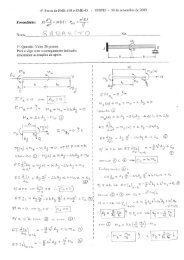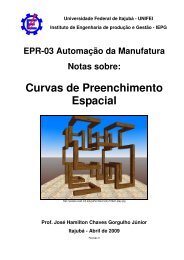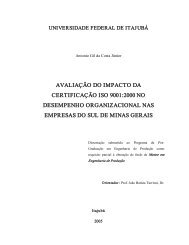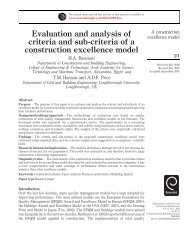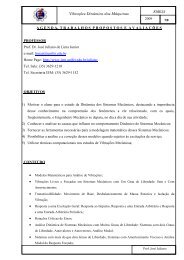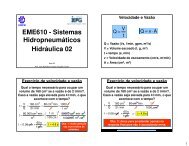526 V. L. Borges et al.Table 7.Summary of and l for polythene sample estimation. (m 2 s 1 ) 10 7 l (W m K 1 ) l (W m K 1 ) (HPM) Error (%)2.14 1.15% 0.383 1.68% 0.389 1.57samples tested. The calculation of the phase fac<strong>to</strong>r numerically is one of the importantadvantages of the technique proposed here. This procedure allows the use of a 3Dtransient model and consequently its application <strong>to</strong> conduc<strong>to</strong>r material <strong>identification</strong>.The estimation of thermophysical properties of complex forms (such as a cutting <strong>to</strong>ol) isa subject for future study.Nomenclaturef ¼ frequency (Hz)G ¼ Green’s function (m 2 KW 1 )H( f ) ¼ frequency response function (m 2 KW 1 )jHð f Þj ¼ modulus of frequency response functionIm(S xy ) ¼ imaginary component of the cross-spectral density function (K 2 )Re(S xy ) ¼ real component of the cross-spectral density function (K 2 )S mq ¼ objective function (K 2 )S ¼ phase objective function (rad 2 )S xx ¼ au<strong>to</strong>espectral density function of x(t) (K 2 )S yy ¼ au<strong>to</strong>espectral density function of y(t) (K 2 )S xy ¼ cross-spectral density function (K 2 )t ¼ time (s)T 0 ¼ initial temperature ( CX(t) ¼ input signal in time domain ( C)Y(t) ¼ output signal in time domain ( C)X( f ) ¼ input signal in frequency domain ( C)Y( f ) ¼ input signal in frequency domain ( Cx, y, z ¼ geometric variables (m)Z ¼ generalized impedance (m 2 KW 1 )Greek symbols ¼ <strong>thermal</strong> diffusivity (m 2 s 1 )l ¼ <strong>thermal</strong> conductivity (W m K 1 ) ¼ heat flux (W m 2 ) ¼ density (kg m 3 ) ¼ temperature difference ( C)( f ) ¼ phase angle (rad)Subscriptst ¼ relative <strong>to</strong> calculated datae ¼ relative <strong>to</strong> experimental data
A <strong>dynamic</strong> <strong>thermal</strong> <strong>identification</strong> <strong>method</strong> 527m ¼ relative <strong>to</strong> integer variables1 ¼ relative <strong>to</strong> the thermocouple 12 ¼ relative <strong>to</strong> the thermocouple 2.AcknowledgementsThe authors thanks CAPES, Fapemig and CNPq.References[1] Huang, C.H. and Yang, J.Y., 1995, An inverse problem in simultaneously measuring temperaturedependent<strong>thermal</strong> conductivity and heat capacity. International Journal of Heat and Mass Transfer, 38,3433–3441.[2] Dowding, K.J., Beck, J.V., Ulbrich, A., Blackwell, B. and Hayes, J., 1995, Estimation of <strong>thermal</strong>properties and surface heat flux in carbon-carbon composite. Journal of Thermophysics and HeatTransfer, 9, 345–351.[3] Guimarães, G., Philippi, P.C. and Thery, P., 1995, Use of parameters estimation <strong>method</strong> in the frequencydomain for the simultaneous estimation of <strong>thermal</strong> diffusivity and conductivity. Review of ScientificInstruments, 66, 2582–2588.[4] Nicolau, V.P., Gu¨ths, S. and Silva, M.G., 2002, Medic¸ão da condutividade te´rmica e do calor especı´ficode materiais isolantes. ENCIT 2002, Brazil.[5] Lima e Silva, S.M.M., Ong, T.H. and Guimara˜es, G., 2003, Thermal properties estimation of polymersusing only one active surface. RBCM, 25, 9–14.[6] Beck, J.V. and Arnold, K.J., 1977, Parameter Estimation in Engineering and Science (New York: JohnWiley and Sons Inc.), p. 501.[7] Bendat, J.S. and Piersol, A.G., 1986, Analysis and Measurement Procedures, 2nd Edn (USA: Wiley-Intersience), p. 566.[8] Özisik, M.N., 1993, Heat Conduction, 2nd Ed (New York: John Wiley & Sons), p. 692.[9] Beck, J.V., Cole, K.D., Haji-Sheik, A., and Litkouhi, B., 1992, Heat Conduction Using Green’s Function(USA: Hemisphere Publishing Corporation), p. 523.[10] Borges, V.L., Lima e Silva, S.M.M., and Guimara¨es, G., 2004, A <strong>dynamic</strong> <strong>thermal</strong> <strong>identification</strong> <strong>method</strong>:part I – non conduc<strong>to</strong>r solid material. Inverse Problems, Design and Optimization Symposium (Brazil: Riode Janeiro).[11] Patankar, S.V., 1980, Numerical Heat Transfer and Fluid Flow (Washing<strong>to</strong>n, DC: Hemisphere PublishingCorporation), p. 197.[12] Vanderplaats, G.N., 1984, Numerical Optimization Techniques for Engineering Design (New York, USA:McGraw-Hill).[13] Lima e Silva, S.M.M., 2000, Experimental Technique Development for Determining Thermal PropertiesDiffusivity and Thermal Conductivity of Non-metallic Materials Using Only One Active Surface. Doc<strong>to</strong>rateThesis (in portuguese), Uberlaˆndia, Brazil: Federal University of Uberlaˆndia, p. 115.[14] Incropera, F.P. and DeWitt, D.P., 1996, Fundamentals of Heat and Mass Transfer (New York: JohnWiley and Sons Inc), p. 886.[15] NPL, 1991, Certificate of calibration: <strong>thermal</strong> conductivity of a pair of polythene specimens, TechnicalReport No. X2321/90/021, England (unpublished).


